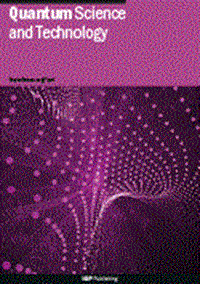Benchmarking digital–analog quantum computation for the inhomogeneous two-body Ising model
IF 5
2区 物理与天体物理
Q1 PHYSICS, MULTIDISCIPLINARY
引用次数: 0
Abstract
Digital–analog quantum computation (DAQC) has recently been proposed as an alternative to the standard paradigm of digital quantum computation (DQC). DAQC generates entanglement through a continuous or analog evolution of the whole device, rather than by applying two-qubit gates. This manuscript describes an in-depth analysis of errors in DAQC implementing Ising Hamiltonians used for arbitrary computations, which was missing from the previous literature, revealing that, overall, DAQC errors scale less favorably compared to those in DQC. As demonstrated, for an all-to-all connectivity, the leading error source for DAQC scales like , while for the digital case, it scales like for implementing an arbitrary Hamiltonian evolution. We further illustrate this result with our own simulations of the Quantum Fourier Transform, which in the previous literature were based on unrealistic parameter choices, biasing the result in favor of DAQC, and were limited to system sizes of up to only seven qubits. On the other hand, we develop a specific DAQC protocol for a star connectivity, which shows an advantage for the particular case of a GHZ state generation protocol.非齐次二体Ising模型的数模量子计算基准
数字模拟量子计算(DAQC)最近被提出作为数字量子计算(DQC)标准范式的替代方案。DAQC通过整个设备的连续或模拟进化产生纠缠,而不是通过应用双量子比特门。本文深入分析了DAQC中用于任意计算的伊辛哈密顿量的误差,这在以前的文献中是缺失的,揭示了总体而言,DAQC中的误差比DQC中的误差更不利。如所示,对于所有到所有的连接,DAQC的主要误差源的规模类似,而对于数字情况,它的规模类似于实现任意哈密顿进化。我们通过自己的量子傅立叶变换模拟进一步说明了这一结果,在之前的文献中,这些模拟是基于不切实际的参数选择,使结果偏向于DAQC,并且仅限于最多只有七个量子位的系统大小。另一方面,我们为星型连接开发了一种特定的DAQC协议,该协议在GHZ状态生成协议的特殊情况下具有优势。
本文章由计算机程序翻译,如有差异,请以英文原文为准。
求助全文
约1分钟内获得全文
求助全文
来源期刊

Quantum Science and Technology
Materials Science-Materials Science (miscellaneous)
CiteScore
11.20
自引率
3.00%
发文量
133
期刊介绍:
Driven by advances in technology and experimental capability, the last decade has seen the emergence of quantum technology: a new praxis for controlling the quantum world. It is now possible to engineer complex, multi-component systems that merge the once distinct fields of quantum optics and condensed matter physics.
Quantum Science and Technology is a new multidisciplinary, electronic-only journal, devoted to publishing research of the highest quality and impact covering theoretical and experimental advances in the fundamental science and application of all quantum-enabled technologies.
 求助内容:
求助内容: 应助结果提醒方式:
应助结果提醒方式:


